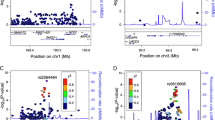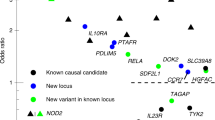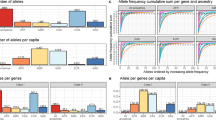Abstract
Using variants from the 1000 Genomes Project pilot European CEU dataset and data from additional resequencing studies, we densely genotyped 183 non-HLA risk loci previously associated with immune-mediated diseases in 12,041 individuals with celiac disease (cases) and 12,228 controls. We identified 13 new celiac disease risk loci reaching genome-wide significance, bringing the number of known loci (including the HLA locus) to 40. We found multiple independent association signals at over one-third of these loci, a finding that is attributable to a combination of common, low-frequency and rare genetic variants. Compared to previously available data such as those from HapMap3, our dense genotyping in a large sample collection provided a higher resolution of the pattern of linkage disequilibrium and suggested localization of many signals to finer scale regions. In particular, 29 of the 54 fine-mapped signals seemed to be localized to single genes and, in some instances, to gene regulatory elements. Altogether, we define the complex genetic architecture of the risk regions of and refine the risk signals for celiac disease, providing the next step toward uncovering the causal mechanisms of the disease.
This is a preview of subscription content, access via your institution
Access options
Subscribe to this journal
Receive 12 print issues and online access
$209.00 per year
only $17.42 per issue
Buy this article
- Purchase on Springer Link
- Instant access to full article PDF
Prices may be subject to local taxes which are calculated during checkout


Similar content being viewed by others
References
Bingley, P.J. et al. Undiagnosed coeliac disease at age seven: population based prospective birth cohort study. Br. Med. J. 328, 322–323 (2004).
West, J. et al. Seroprevalence, correlates, and characteristics of undetected coeliac disease in England. Gut 52, 960–965 (2003).
van Heel, D.A. et al. A genome-wide association study for celiac disease identifies risk variants in the region harboring IL2 and IL21. Nat. Genet. 39, 827–829 (2007).
Hunt, K.A. et al. Newly identified genetic risk variants for celiac disease related to the immune response. Nat. Genet. 40, 395–402 (2008).
Dubois, P.C. et al. Multiple common variants for celiac disease influencing immune gene expression. Nat. Genet. 42, 295–302 (2010).
Trynka, G. et al. Coeliac disease-associated risk variants in TNFAIP3 and REL implicate altered NF-κB signalling. Gut 58, 1078–1083 (2009).
Zhernakova, A., van Diemen, C.C. & Wijmenga, C. Detecting shared pathogenesis from the shared genetics of immune-related diseases. Nat. Rev. Genet. 10, 43–55 (2009).
Smyth, D.J. et al. Shared and distinct genetic variants in type 1 diabetes and celiac disease. N. Engl. J. Med. 359, 2767–2777 (2008).
Zhernakova, A. et al. Meta-analysis of genome-wide association studies in celiac disease and rheumatoid arthritis identifies fourteen non-HLA shared loci. PLoS Genet. 7, e1002004 (2011).
Cortes, A. & Brown, M.A. Promise and pitfalls of the Immunochip. Arthritis Res. Ther. 13, 101 (2011).
1000 Genomes Project Consortium. A map of human genome variation from population-scale sequencing. Nature 467, 1061–1073 (2010).
Clayton, D.G. et al. Population structure, differential bias and genomic control in a large-scale, case-control association study. Nat. Genet. 37, 1243–1246 (2005).
Galarneau, G. et al. Fine-mapping at three loci known to affect fetal hemoglobin levels explains additional genetic variation. Nat. Genet. 42, 1049–1051 (2010).
Spencer, C., Hechter, E., Vukcevic, D. & Donnelly, P. Quantifying the underestimation of relative risks from genome-wide association studies. PLoS Genet. 7, e1001337 (2011).
Lango Allen, H. et al. Hundreds of variants clustered in genomic loci and biological pathways affect human height. Nature 467, 832–838 (2010).
van Heel, D.A., Hunt, K., Greco, L. & Wijmenga, C. Genetics in coeliac disease. Best Pract. Res. Clin. Gastroenterol. 19, 323–339 (2005).
Zhernakova, A. et al. Evolutionary and functional analysis of celiac risk loci reveals SH2B3 as a protective factor against bacterial infection. Am. J. Hum. Genet. 86, 970–977 (2010).
Holm, H. et al. A rare variant in MYH6 is associated with high risk of sick sinus syndrome. Nat. Genet. 43, 316–320 (2011).
Lesage, S. et al. CARD15/NOD2 mutational analysis and genotype-phenotype correlation in 612 patients with inflammatory bowel disease. Am. J. Hum. Genet. 70, 845–857 (2002).
Johansen, C.T. et al. Excess of rare variants in genes identified by genome-wide association study of hypertriglyceridemia. Nat. Genet. 42, 684–687 (2010).
Asimit, J. & Zeggini, E. Rare variant association analysis methods for complex traits. Annu. Rev. Genet. 44, 293–308 (2010).
Dickson, S.P., Wang, K., Krantz, I., Hakonarson, H. & Goldstein, D.B. Rare variants create synthetic genome-wide associations. PLoS Biol. 8, e1000294 (2010).
Zheng, Q. & Wang, X.J. GOEAST: a web-based software toolkit for Gene Ontology enrichment analysis. Nucleic Acids Res. 36, W358–W363 (2008).
Lanktree, M.B. et al. Meta-analysis of dense gene-centric association studies reveals common and uncommon variants associated with height. Am. J. Hum. Genet. 88, 6–18 (2011).
Donnelly, P. Progress and challenges in genome-wide association studies in humans. Nature 456, 728–731 (2008).
Lowe, C.E. et al. Large-scale genetic fine mapping and genotype-phenotype associations implicate polymorphism in the IL2RA region in type 1 diabetes. Nat. Genet. 39, 1074–1082 (2007).
Genovese, G. et al. Association of trypanolytic ApoL1 variants with kidney disease in African Americans. Science 329, 841–845 (2010).
Shea, J. et al. Comparing strategies to fine-map the association of common SNPs at chromosome 9p21 with type 2 diabetes and myocardial infarction. Nat. Genet. 43, 801–805 (2011).
Jostins, L., Morley, K.I. & Barrett, J.C. Imputation of low-frequency variants using the HapMap3 benefits from large, diverse reference sets. Eur. J. Hum. Genet. 19, 662–666 (2011).
Asano, A., Tsubomatsu, K., Jung, C.G., Sasaki, N. & Agui, T. A deletion mutation of the protein tyrosine phosphatase kappa (Ptprk) gene is responsible for T-helper immunodeficiency (thid) in the LEC rat. Mamm. Genome 18, 779–786 (2007).
Adrianto, I. et al. Association of a functional variant downstream of TNFAIP3 with systemic lupus erythematosus. Nat. Genet. 43, 253–258 (2011).
Musunuru, K. et al. From noncoding variant to phenotype via SORT1 at the 1p13 cholesterol locus. Nature 466, 714–719 (2010).
Wellcome Trust Case Control Consortium. Genome-wide association study of 14,000 cases of seven common diseases and 3,000 shared controls. Nature 447, 661–678 (2007).
Anonymous. Revised criteria for diagnosis of coeliac disease. Report of Working Group of European Society of Paediatric Gastroenterology and Nutrition. Arch. Dis. Child. 65, 909–911 (1990).
Romanos, J. . et al. Six new coeliac disease loci replicated in an Italian population confirm association with coeliac disease. J. Med. Genet. 46, 60–63 (2009).
Plaza-Izurieta, L. et al. Revisiting genome wide association studies (GWAS) in coeliac disease: replication study in Spanish population and expression analysis of candidate genes. J. Med. Genet. 48, 493–496 (2011).
Megiorni, F. et al. HLA-DQ and risk gradient for celiac disease. Hum. Immunol. 70, 55–59 (2009).
Purcell, S. et al. PLINK: a tool set for whole-genome association and population-based linkage analyses. Am. J. Hum. Genet. 81, 559–575 (2007).
Pruim, R.J. et al. LocusZoom: regional visualization of genome-wide association scan results. Bioinformatics 26, 2336–2337 (2010).
Risch, N.J. Searching for genetic determinants in the new millennium. Nature 405, 847–856 (2000).
Acknowledgements
We thank Coeliac UK for assistance with direct recruitment of individuals with celiac disease and the clinicians from the UK (L.C. Dinesen, G.K.T. Holmes, P.D. Howdle, J.R.F. Walters, D.S. Sanders, J. Swift, R. Crimmins, P. Kumar, D.P. Jewell, S.P.L. Travis and K. Moriarty) who recruited individuals with celiac disease to provide blood samples as described in our previous studies. We thank the Dutch clinicians for recruiting individuals with celiac disease to provide blood samples as described in our previous studies (C.J. Mulder, G.J. Tack, W.H.M. Verbeek, R.H.J. Houwen and J.J. Schweizer). We thank the genotyping facility of the University Medical Center Groningen (UMCG) (P. van der Vlies) for help in generating some of the Immunochip data and S. Jankipersadsing and A. Maatman at the UMCG for preparation of the samples. We thank R. Scott for preparing samples for genotyping and the staff at the University of Pittsburgh Genomics and Proteomics Core Laboratories for performing the genotyping. We thank C. Wallace for assistance with Immunochip SNP selection and J. Stone for coordinating the Immunochip design and production at Illumina. We thank the members of each disease consortium who initiated and sustained the cross-disease Immunochip project. We thank all individuals with celiac disease and all controls for participating in this study.
Funding was provided by the Wellcome Trust (084743 to D.A.v.H.), by grants from the Celiac Disease Consortium and an Innovative Cluster approved by the Netherlands Genomics Initiative. Partial funding was provided by the Dutch Government (BSIK03009 to C. Wijmenga) and the Netherlands Organisation for Scientific Research (NWO, grant 918.66.620 to C. Wijmenga). Funding was also provided by the US National Institutes of Health grant 1R01CA141743 (to R.H.D.) and Fondo de Investigación Sanitaria grants FIS08/1676 and FIS07/0353 (to E.U.). This research utilized resources provided by the Type 1 Diabetes Genetics Consortium, a collaborative clinical study sponsored by the National Institute of Diabetes and Digestive and Kidney Diseases, the National Institute of Allergy and Infectious Diseases, the National Human Genome Research Institute, the National Institute of Child Health and Human Development and the Juvenile Diabetes Research Foundation International and is supported by the US National Institutes of Health grant U01-DK062418. We acknowledge use of DNA from The UK Blood Services collection of Common Controls (UKBS-CC collection), which is funded by the Wellcome Trust grant 076113/C/04/Z and by US National Institute for Health Research program grant to the National Health Service Blood and Transplant (RP-PG-0310-1002). The collection was established as part of the WTCCC33. We acknowledge the use of DNA from the British 1958 Birth Cohort collection, which is funded by the UK Medical Research Council grant G0000934 and the Wellcome Trust grant 068545/Z/02. S.S. is supported by a Senior Research Fellowship from the Council for Scientific and Industrial Research (CSIR), New Dehli, India.
Author information
Authors and Affiliations
Consortia
Contributions
D.A.v.H. and C. Wijmenga led the study. D.A.v.H., K.A.H., G.T. and C. Wijmenga wrote the paper. K.A.H., G.T., V.Mistry, N.A.B., J.R., M.P., M.Mitrovic, R.H.D. and K.F. performed DNA sample preparation and genotyping assays. D.A.v.H., V.P., K.A.H. and G.T. performed the statistical analysis. All other authors contributed primarily to the sample collection and phenotyping. P.D. led the formation of the Immunochip Consortium, and SNP selection was performed by J.C.B. and C. Wallace. All authors reviewed the final manuscript.
Corresponding authors
Ethics declarations
Competing interests
The authors declare no competing financial interests.
Additional information
A list of members is provided in the Supplementary Note.
A list of members is provided in the Supplementary Note.
A list of members is provided in the Supplementary Note.
Supplementary information
Supplementary Text and Figures
Supplementary Note, Supplementary Tables 3 and 5 and Supplementary Figures 1 and 2. (PDF 5648 kb)
Supplementary Table 1
Comparison of risk signals reported in our 2010 celiac disease GWAS versus the current Immunochip dataset (XLSX 59 kb)
Supplementary Table 2
Functional annotation of identified risk variants and strongly correlated (r2 > 0.9) variants (XLSX 75 kb)
Supplementary Table 4
Genotype count and allele frequency data by sample collection and affection status (XLSX 33 kb)
Rights and permissions
About this article
Cite this article
Trynka, G., Hunt, K., Bockett, N. et al. Dense genotyping identifies and localizes multiple common and rare variant association signals in celiac disease. Nat Genet 43, 1193–1201 (2011). https://doi.org/10.1038/ng.998
Received:
Accepted:
Published:
Issue Date:
DOI: https://doi.org/10.1038/ng.998
This article is cited by
-
Relationship between vitamin D levels and pediatric celiac disease: a systematic review and meta-analysis
BMC Pediatrics (2024)
-
Exploring potential causal associations between autoimmune diseases and colorectal cancer using bidirectional Mendelian randomization
Scientific Reports (2024)
-
Cross-disorder genetic analysis of immune diseases reveals distinct gene associations that converge on common pathways
Nature Communications (2023)
-
Investigation of the causal relationship between ALS and autoimmune disorders: a Mendelian randomization study
BMC Medicine (2022)
-
Splicing QTL analysis focusing on coding sequences reveals mechanisms for disease susceptibility loci
Nature Communications (2022)



